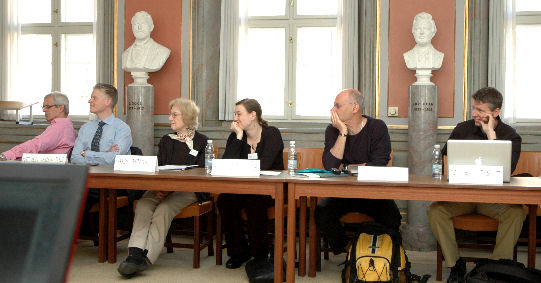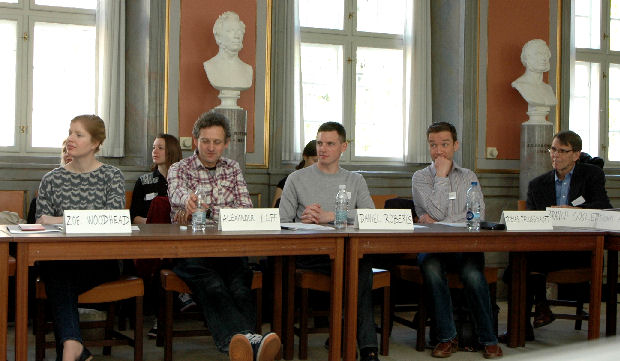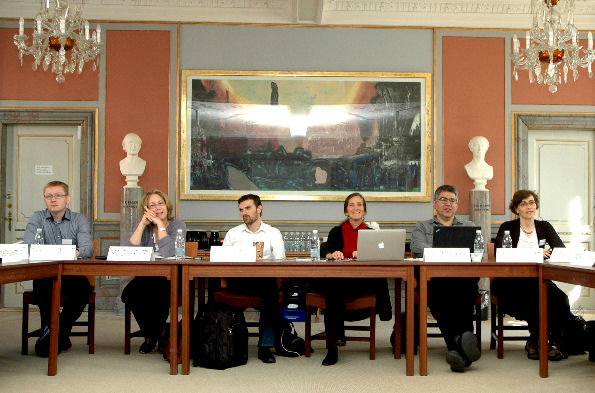 |
Pure alexia symposium Copenhagen University May 15-17, 2013
Organized by |
 |
Pure alexia symposium Copenhagen University May 15-17, 2013
Organized by |
|
by Anders Gade, with a bit of input from Randi |
| Morning session, May 15th | Introduction by Randi Starrfelt |
 |
Defining pure alexia. Core questions in current pure alexia research
Randi Starrfelt |
 |
 |
|
|
Richard Wise, Matt Lambon-Ralph, Karalyn Patterson, Anna Woollams, Dan Bub, Dan Fiset |
Zoe Woodhead, Alex Leff, Dan Roberts, Tobias Pflugshaupt, Branch Coslett |
 |
|
 |
| Thomas Habekost, Brenda Rapp, Jeremy Purcell, Argye Hillis, David Plaut, Marlene Behrmann |
 |
The symposium was held in one of the central university buildings at Cathedral Square, Copenhagen
|
|
| Michael McCloskey, Jonathan Grainger, Stanislas Dehaene, Laurent Cohen, Elizabeth Warrington |
 |
Dan Bub Dejerine and the history of pure alexia |
|
|
Joseph Jules Dejerine (1849-1917) |
||
|
Bub, D. N., Arguin, M., & Lecours, A. R.
(1993). Jules Dejerine and his interpretation of pure alexia. Brain
and Language, 45, 531-559. |
Min egen historie om Dejerine og hans patient Oscar C (Introduktion til bogen "Hjerneprocesser", 1997 _ Hvis jeg må prale lidt: Jeg omtalte også Oscar C's serielle tal-for-tal læsning (112 -> 1-1-2) - men så havde jeg også læst både Dejerines egen oprindelige beskrivelse fra 1892 i uddrag og Dans 1993-artikel) |
| Bub introduced some of the lesser known aspects of Oscar C’s disorder, and hinted that his deficit may have been less ’pure’ than commonly believed. He asked whether Oscar C perhaps did have subtle writing difficulties following his first stroke. He also noted that there were contradictions in the original reports as to whether Oscar could read numbers normally or not. The suggested normal reading of numbers in pure alexic patients has been at the core of the debate about the ‘purity’ of pure alexia. The literature was recently reviewed by Randi Starrfelt & Marlene Behrmann, who found no clear evidence for such a dissociation in performance. (Starrfelt & Behrmann (2011). Number reading in pure alexia: A review. Neuropsychologia, 49; 2283 – 2298_ pdf) |
|
|
Matthew Lambon-Ralph
Differences in severity or in kind? Are there different forms of pure alexia?
|
|
| Is pure alexia a result of a more basic visual processing disorder? Four talks on this controversial topic: |
 |
Elizabeth Warrington UCL Institute of Neurology, University College London, London, UK
Evidence from two patients with posterior cortical atrophy and profound visual impairment - and good reading (Yong et al., in press, see below)
During more than 50 years, Elizabeth has contributed greatly to the study of alexias - as she has to so many other areas. Selected references. A classic in the pure alexia literature: Warrington, E. K. & Shallice, T. (1980). Word-form dyslexia. Brain, 103, 99-112.
|
|
Yong, K. X.,
Warren, J. D., Warrington, E. K., & Crutch, S. J. (2013). Intact reading
in patients with profound early visual dysfunction. Cortex. |
 |
Daniel Fiset Université du Quebec
On letter-by-letter reading, letter confusability effect from visual similarity in letters, and spatial frequency
Fiset, D., Gosselin, F., Blais, C., & Arguin, M. (2006). Inducing letter-by-letter dyslexia in normal readers. Journal of Cognitive Neuroscience, 18, 1466-1476. |
|
Anna Woollams Neuroscience and Aphasia Research Unit, School of Psychological Sciences, University of Manchester, Manchester, UK
Case series of patients
|
 |
|
Roberts, D.
J., Woollams, A. M., Kim, E., Beeson, P. M., Rapcsak, S. Z., & Lambon
Ralph, M. A. (2012). Efficient Visual Object and Word Recognition Relies
on High Spatial Frequency Coding in the Left Posterior Fusiform Gyrus:
Evidence from a Case-Series of Patients with Ventral Occipito-Temporal
Cortex Damage. Cerebral Cortex. |
 |
Thomas Habekost & Randi Starrfelt Dept. of Psychology, Copenhagen University
Thomas and Randi have previously published on the importance of subtle low level visual deficits for pure alexia:
Starrfelt, R.,
Habekost, T., & Gerlach, C. (2010). Visual processing in pure alexia: a
case study. Cortex, 46, 242-255.
pdf
Here they presented new data with gabor gratings used with case LK: Starrfelt, Nielsen, Habekost & Andersen (in press). How low can you go: Spatial frequency sensitivity in pure alexia. Brain & Language. |
 |
Randi Starrfelt Randi and Thomas have previously investigated the subtle visual deficits in pure alexia using methods based on a Theory of Visual Attention (TVA, see http://cvc.psy.ku.dk/), and suggested that the patients perceive “Too little – too late” to read fast and fluently. They are now working on extending their paradigm to investigate the speed of visual word processing in pure alexia, and presented data from this project. Starrfelt, R., Habekost, T., & Leff, A. P. (2009). Too little, too late: reduced visual span and speed characterize pure alexia. Cerebral Cortex, 19, 2880-2890 pdf
|
|
Thomas Habekost Copenhagen
Thomas and Christian have collaborated with Randi Starrfelt on much of her work on pure alexia and visual word processing, e.g.
Starrfelt, R. & Gerlach, C. (2007). The visual what for area: words and
pictures in the left fusiform gyrus. NeuroImage,
|
 |
 |
Marlene Behrmann Department of Psychology, Center for the Neural Basis of Cognition, Carnegie Mellon University, Pittsburgh, PA, USA
|
|
| More |
|
Behrmann, M. &
Plaut, D. C. (2013). Bilateral Hemispheric Processing of Words and Faces:
Evidence from Word Impairments in Prosopagnosia and Face Impairments in
Pure Alexia. Cerebral Cortex. |
| Discussion. A very lively discussion followed these talks. Among the many discussants were: |
|
Richard J. Wise London
With Zoe Woodhead and others, Richard has with fMRI explored how the two hemispheres respond to sine-wave gratings varying in spatial frequency
Woodhead, Z. V., Wise, R. J., Sereno, M., & Leech, R. (2011). Dissociation of sensitivity to spatial frequency in word and face preferential areas of the fusiform gyrus. Cerebral Cortex, 21, 2307-2312.
|
 |
|
Randi Starrfelt |
 |
Dan Bub |
 |
| David Plaut | Matt Lambon-Ralph |
 |
 |
| Afternoon session |
| The role of visual field defects in pure alexia |
|
Tobias Pflugshaupt Luzern, Schwitzerland
Introduction
Pflugshaupt, T., Gutbrod, K., Wurtz, P., von Wartburg, R., Nyffeler, T.,
De Haan, B. et al. (2009). About the role of visual field defects in
pure alexia. Brain, 132, 1907-1917. |
 |
 |
Jason Barton University of British Columbia, Vancouver, Canada
Sheldon, C. A., Abegg, M., Sekunova, A., & Barton, J. J. (2012). The word-length effect in acquired alexia, and real and virtual hemianopia. Neuropsychologia, 50, 841-851.
|
| Afternoon session continued: i) Is the visual word form area reading specific ? ii) Is the visual word form area the core orthographic processing region for reading? |
|
Brenda Rapp Department of Cognitive Science, Johns Hopkins University, Baltimore
|
 |
 |
Argye Hillis Department of Neurology, Johns Hopkins University School of Medicine, Johns Hopkins Hospital, 600 N. Wolfe Street, Baltimore, MD
Hillis, A. E., Newhart, M., Heidler, J., Barker, P., Herskovits, E., &
Degaonkar, M. (2005). The roles of the "visual word form area" in
reading. NeuroImage, 24, 548-559. -- and much more |
 |
H. Branch Coslett Department of Neurology, University of Pennsylvania, Philadelphia
Case report :
Turkeltaub, P. E., et al. (2013). Alexia due to ischemic stroke of the
visual word form area. Neurocase, in press
... Branch Coslett has published a great number of papers on reading and alexia, including chapters on alexia in some of the most authoritative textbooks |
|
Laurent Cohen Department of Neurology, Hopital de la Salpetriere, Paris
discussant
Dehaene, S. & Cohen, L. (2011). The unique role of the visual word form area in reading. Trends in Cognitive Sciences, 15, 254-262.
Stan Dehaene & Laurent
Cohen |
 |
| May 16th, morning session |
|
Introduction by
Tim Shallice Institute of Cognitive Neuroscience, University College, London, UK
How does the compensatory mechanism in pure alexia (LBL-reading) work ?
|
 |
| Models of orthograpic processing and pure alexia - talks by Grainger and McCloskey |
 |
Jonathan Grainger Laboratoire de Psychologie Cognitive,
... evidence from experiments, many of which used event-related potentials (ERPs) to examine the time course of visual word recognition using masked repetition priming paradigms
|
|
Michael McCloskey Department of Cognitive Sciences,
.. evidence from letter position in spelling
|
 |
| Max Coltheart could unfortunately not attend. His position was nicely given by Daniel Bub and Daniel Fiset. Here I list a few of his many papers on alexia, with an emphasis on books and position papers, as well as recent works on his computational model of reading |
|
The afternoon session: "What can "implicit reading" tell us about pure alexia?" was introduced by Karalyn Patterson,
Karalyn Patterson MRC Cognition and Brain Sciences Unit,
|
 |
|
|
Karalyn contributed
one of the 'classics' in the pure alexia literature: She is an expert on semantic dementia, which is also characterized by surface alexia. This condition is suitable for testing notions about top-down influences on reading (see below) In her talk, she also presented data from Lambon-Ralph, M. A., Hesketh, A., & Sage, K. (2004). Implicit recognition in pure alexia: The Saffran effect - A tale of two systems or two procedures? Cognitive Neuropsychology, 21, 401-421. abstract
|
 |
Woollams, A. M., Ralph, M. A., Plaut, D. C., & Patterson, K. (2007).
SD-squared: on the association between semantic dementia and surface
dyslexia. Psychological Review, 114, 316-339. Within the connectionist triangle model of reading aloud, interaction between semantic and phonological representations occurs for all words but is particularly important for correct pronunciation of lower frequency exception words. This framework therefore predicts that (a) semantic dementia, which compromises semantic knowledge, should be accompanied by surface dyslexia, a frequency-modulated deficit in exception word reading, and (b) there should be a significant relationship between the severity of semantic degradation and the severity of surface dyslexia. The authors evaluated these claims with reference to 100 observations of reading data from 51 cases of semantic dementia. Surface dyslexia was rampant, and a simple composite semantic measure accounted for half of the variance in low-frequency exception word reading. Although in 3 cases initial testing revealed a moderate semantic impairment but normal exception word reading, all of these became surface dyslexic as their semantic knowledge deteriorated further. The connectionist account attributes such cases to premorbid individual variation in semantic reliance for accurate exception word reading. These results provide a striking demonstration of the association between semantic dementia and surface dyslexia, a phenomenon that the authors have dubbed SD-squared |
|
| Anna Woollams. Medical Research Council (MRC) Cognition and Brain Sciences Unit, Cambridge, United Kingdom. anna.woollams@mrc-cbu.cam.ac.uk |
|
Zoe Woodhead MRC Clinical Sciences Centre,
|
 |
|
Woodhead, Z. V., Brownsett, S. L., Dhanjal, N. S., Beckmann, C., & Wise,
R. J. (2011). The visual word form system in context. Journal of
Neuroscience, 31, 193-199. |
| 2nd afternoon session: Lateralization in reading and visual processing |
 |
Jason Barton University of British Columbia, Vancouver, Canada
|
|
Marlene Behrmann
Department of Psychology,
Recent and selected references on |
 |
|
Behrmann, M. & Plaut, D. C. (2013). Distributed circuits, not
circumscribed centers, mediate visual recognition. Trends in
Cognitive Sciences, 17, 210-219. Notes: Increasingly, the neural mechanisms that support visual cognition are being conceptualized as a distributed but integrated system, as opposed to a set of individual, specialized regions that each subserve a particular visual behavior. Consequently, there is an emerging emphasis on characterizing the functional, structural, and computa tional properties of these broad networks. We present a novel theoretical perspective, which elucidates the developmental emergence, computational properties, and vulnerabilities of integrated circuits using face and word recognition as model domains. Additionally, we suggest that, rather than being disparate and independent, these neural circuits are overlapping and subject to the same computational constraints. Specifically, we argue that both word and face recognition rely on fine-grained visual representations but, by virtue of pressure to couple visual and language areas and to keep connection length short, the left hemisphere becomes more finely tuned for word recognition and, consequently, the right hemisphere becomes more finely tuned for face recognition. Thus, both hemispheres ultimately participate in both forms of visual recognition, but their respective contributions are asymmetrically weighted |
 |
Dan Roberts School of
Psychology,
Judging faces at word value: Is "pure " alexia the black swan? Dan presented data from a case-series of 19 pure alexic patients who were impaired at face processing, and concluded that a similar part-based strategy is adopted to recognize words (letter-by-letter reading) and faces (featue-by-feature face processing)
Roberts, D. J., Woollams, A. M., Kim, E., Beeson, P. M., Rapcsak, S. Z., & Lambon Ralph, M. A. (2012). Efficient Visual Object and Word Recognition Relies on High Spatial Frequency Coding in the Left Posterior Fusiform Gyrus: Evidence from a Case-Series of Patients with Ventral Occipito-Temporal Cortex Damage. Cerebral Cortex. |
|
Roberts, D. J., Lambon Ralph, M. A., & Woollams, A. M. (2010). When does
less yield more? The impact of severity upon implicit recognition in
pure alexia. Neuropsychologia, 48, 2437-2446. Notes: Pure alexia (PA) is characterised by strong effects of word length on reading times and is sometimes accompanied by an overt letter-by-letter (LBL) reading strategy. Past studies have reported "implicit recognition" in some individual PA patients. This is a striking finding because such patients are able to perform semantic classification and lexical decision at above chance levels even when the exposure duration is short enough to prevent explicit identification. In an attempt to determine the prevalence of this "implicit recognition" effect, we assessed semantic categorisation and lexical decision performance using limited exposure durations in 10 PA cases. The majority of the patients showed above chance accuracy in semantic categorisation and lexical decision. Performance on the lexical decision test was influenced by frequency and imageability. In addition, we found that the extent to which patients showed evidence of "implicit recognition" in both tasks was inversely related to the severity of their reading disorder. This result is consistent with hypotheses which suggest that this effect does not constitute an implicit form of unique word identification but is a reflection of the degree of partial activation within the word recognition system. These results also go some way towards explaining the individual variation in the presence of this effect observed across previous case-study investigations in the literature |
| Predictably, the session ended with an animated discussion. There are many uncertain points, and pure alexia will continue to be a fruitful area of research for some time to come. |
| Brenda Rapp and Jeremy Purcell, both Department of Cognitive Science, Johns Hopkins University, Baltimore |
 |
 |
Alexander Leff |
|
Alexander Leff Institute of Neurology, University College London, UK |
 |
 |
During the meeting, spring arrived in Denmark. Here are two of Randi's student research assistants
crossing the yard between the hotel and the conference room:
|
 |
| Photography and layout: Anders.Gade@psy.ku.dk |
| Link to Picasa webalbum |